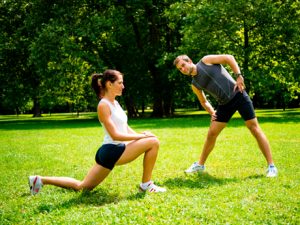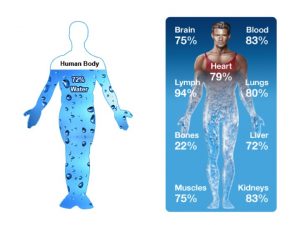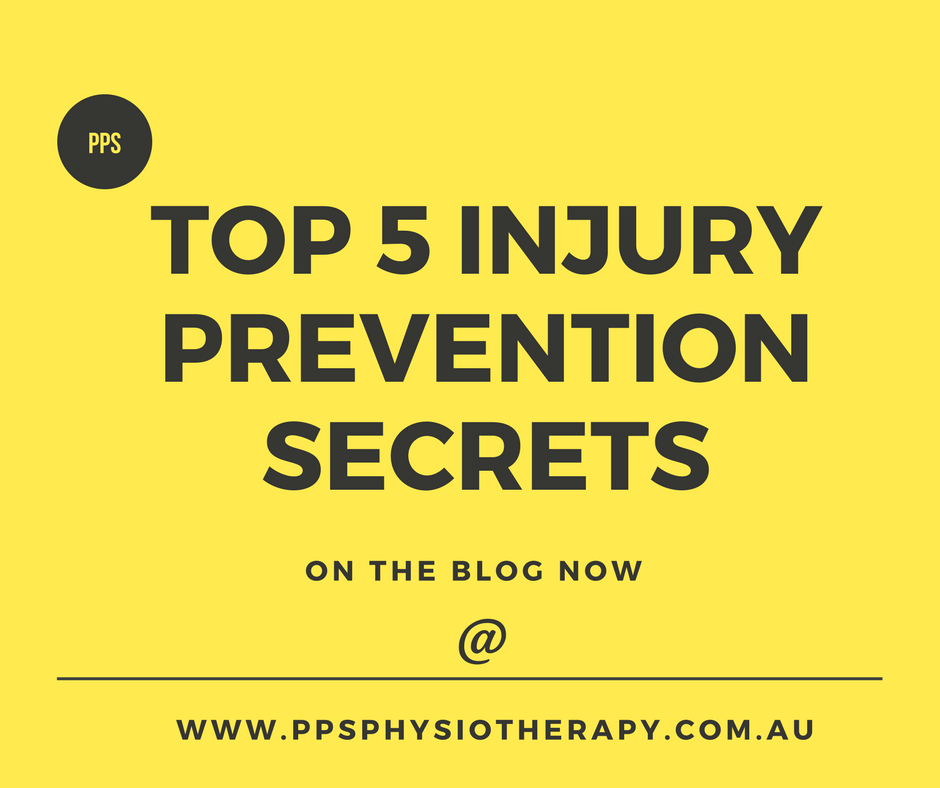6th March 2017, Kimberley Cochrane, Bach Physiotherapy First Class Honors
Do you feel like you are always getting injured?
Do injuries cost you a fortune at the GP, specialist and physio?
Do you want to know how to stop getting injured?
Despite being quiet painful, injuries can stop you from doing the things you love, may stop you from earning an income, can cause emotional and psychological changes and may lead to long term pain if not treated properly.
BUT fear not!!! The team at PPS Physiotherapy have put together their Top 5 Injury Prevention Secrets to keep you at your peak function.
- Always warm up and cool down prior to activity
It’s tempting to rush from work to your weeknight sports game or training and jump straight on without warming up. Ok, you can probably get away with it when you are 10 (not that we recommend it is ok for children) but by the time you have hit your adult years it’s even more crucial. Warming up prepares your muscles, joints and ligaments for the increased workload that is to follow. You wouldn’t start your car in the middle of winter and drive at 100km/h straight away right. 
Warming up can result in better performance, reduced injury risk and better recovery post activity. We would encourage you to warm up for about 10 minutes using dynamic movements that mimic the sport or activity you will do. Eg: walking lunges, squats, step ups etc
Cool down for 5-10mins post activity to assist with your recovery.
- If it’s sore and niggling get it seen to ASAP
We often see people in the clinic who say “this has been playing up on and off for months”. When we ask why they have decided to come now the usual answer is “it’s getting worse” or “it’s not getting any better”. Yes, some problems will run their natural course and with rest may resolve. However, this is usually not the case.
The earlier we can catch a problem the less time it will take to fix. If you have been living with a sore knee for a few years chances are you have started walking differently and have been avoiding putting weight through that leg. This can lead to additional problems with hip and back pain due to changes in the way you are loading.
Moral of the story: Get it seen to!
- Balance, Balance, Balance
There are 2 types of people in the physio world. Those that love exercise and can’t get enough of it and those that find it a real struggle to start.
This is more aimed at those who exercise a lot. As great as exercise is for you, it can have the reverse effect if you are overdoing it. Muscles, ligaments, tendons and bones need time to recover, heal and grow post exercise. We commonly see overuse problems in this population including tendinopathies, stress fractures, and repetitive strain injuries.
Reduce the risk of injury by mixing up your exercise routine ensuring you include some weight bearing and non-weight bearing activity, high intensity and low intensity activities, high volume and low volume, cardio and weights, stretching and ‘rehab’ work. You may also benefit from a training principle called periodisation (a concept where you cycle through different blocks throughout the year depending on your goals and any competitions).
If you are someone who enjoys routine and the daily grind the other things to be mindful of include; walking the same route (beware of cambers of the road/path), cycling/running the same direction around a track and getting stuck in a rut with the same exercise routine.
- Fluid and Nutrition
Exercise and physical activity is only one variable in the injury sphere. As mentioned above, exercise induces a degree of damage to our muscles which is essential for growth and change. This growth and change needs to be fueled and also replenished.
Quality nutrition = quality cells = quality body tissues.
As the saying goes you wouldn’t run your car on an empty tank or a tank of poor quality fuel so don’t do it to your body either.
A mix of protein carbs and fats are required for energy production and recovery. People will have different energy and macro nutrient needs depending on their job, activity and training regime. A good start however is to consume a well-rounded diet of fruits, vegetables, lean proteins and healthy fats.
Your body is composed of 60-70% water so before, during and after exercise you should make sure you are hydrating your body.

- Technique
No matter if you are playing a sport, are at work or are doing some things around the house on a weekend, if you consistently move with poor technique chances are you will end up injured.
In a throwing athlete minor changes to form can result in injury or overload to a specific muscle. For our office workers, sitting with a poor posture for 8 hours a day will eventually catch up to you. Tradies you are not immune either! If you lift with poor technique and repeatedly bend from your hips and back this is likely to cause injury.
Many people think of injuries being related to sports and associated activity. However, clinically this is usually not the case. Yes, sports related injuries form part of our caseload but it is far more common to hear “I did lots of gardening on the weekend and now my back is sore” or “I have an office job and my neck has been really niggly the last few weeks”. These all come down to technique issues!
We hope you find these tips helpful and assist you to prevent injury occurrence. Remember we are always here to offer advice and guidance so feel free to ask our physio’s any questions you may have.
If you want to know more on how to prevent injury from happening, contact our Carlingford (02) 9871 2022 and Kellyville (02) 9672 6752 clinics today. We also provide physio services on Castle Hill, Epping, Baulkham Hills and nearby areas.

